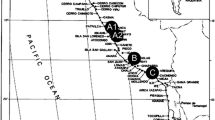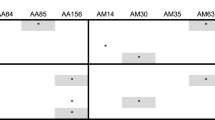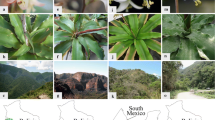Abstract
Artificial second generation and backcross hybrids involvingEchinocereus dasyacanthus (Texas rainbow cactus),E. coccineus (a species of claret-cup cactus), andE. ×lloydii (Lloyd's hedgehog cactus) were examined for morphological and reproductive characteristics. The hybrids grew from seed to flower in about four years, and they exhibited high fertility as measured by pollen stainability, crossability, and fruit-set. A rare breeding system inCactaceae, dioecy, was further examined inE. coccineus, using field and controlled pollination tests. Functional dioecy was documented forE. coccineus in Trans-Pecos Texas. All results suggested thatE. ×lloydii in eastern Pecos County, Texas, is a complex and dynamic population probably comprising first and later generation hybrids, including backcross hybrids. The experimental hybridizations also tended to support the occurrence of introgression into both putative parental species.
Similar content being viewed by others
References
Benson, L., 1982: The cacti of the United States and Canada. — Stanford, CA: Stanford University Press.
Federal Register, 1979: Fish and Wildlife Service, Endangered and Threatened Wildlife and Plants,44: (209) 916. — US Government Printing Office.
Ferguson, D. J., 1989: Revision of the U. S. members of theEchinocereus triglochidiatus group. — Cact. Succ. J. (USA)61: 217–224.
Grant, V., 1977: Organismic evolution. — San Francisco: Freeman.
Hoffman, M. T., 1992: Functional dioecy inEchinocereus coccineus (Cactaceae): breeding system, sex ratios, and geographic range of floral dimorphism. — Amer. J. Bot.79: 1382–1388.
Parfitt, B. D., 1985: Dioecy in North AmericanCactaceae: a review. — Sida11: 200–206.
Pinkava, D. J., Baker, M. A., Parfitt, B. D., Mohlenbrock, M. W., Worthington, R. D., 1985: Chromosome numbers in some cacti of Western North America. V. — Syst. Bot.10: 471–483.
Poole, J. M., Riskind, D. H., 1987: Endangered, threatened, or protected native plants of Texas. — Austin: Texas Parks and Wildlife Department.
Powell, A. M., Zimmerman, A. D., Hilsenbeck, R. A., 1991: Experimental documentation of natural hybridization inCactaceae: origin of Lloyd's Hedgehog Cactus,Echinocereus ×lloydii. — Pl. Syst. Evol.178: 107–122.
Weedin, J. F., Powell, A. M., 1978: Chromosome numbers in Chihuahuan DesertCactaceae. Trans-Pecos Texas. — Amer. J. Bot.65: 531–537.
, 1989: Chromosome numbers in Chihuahuan DesertCactaceae. II. Trans-Pecos Texas. — Southwest. Naturalist34: 160–164.
Author information
Authors and Affiliations
Rights and permissions
About this article
Cite this article
Powell, A.M. Second generation experimental hybridizations in theEchinocereus ×lloydii complex (Cactaceae), and further documentation of dioecy inE. coccineus . Pl Syst Evol 196, 63–74 (1995). https://doi.org/10.1007/BF00985335
Received:
Revised:
Accepted:
Issue Date:
DOI: https://doi.org/10.1007/BF00985335




